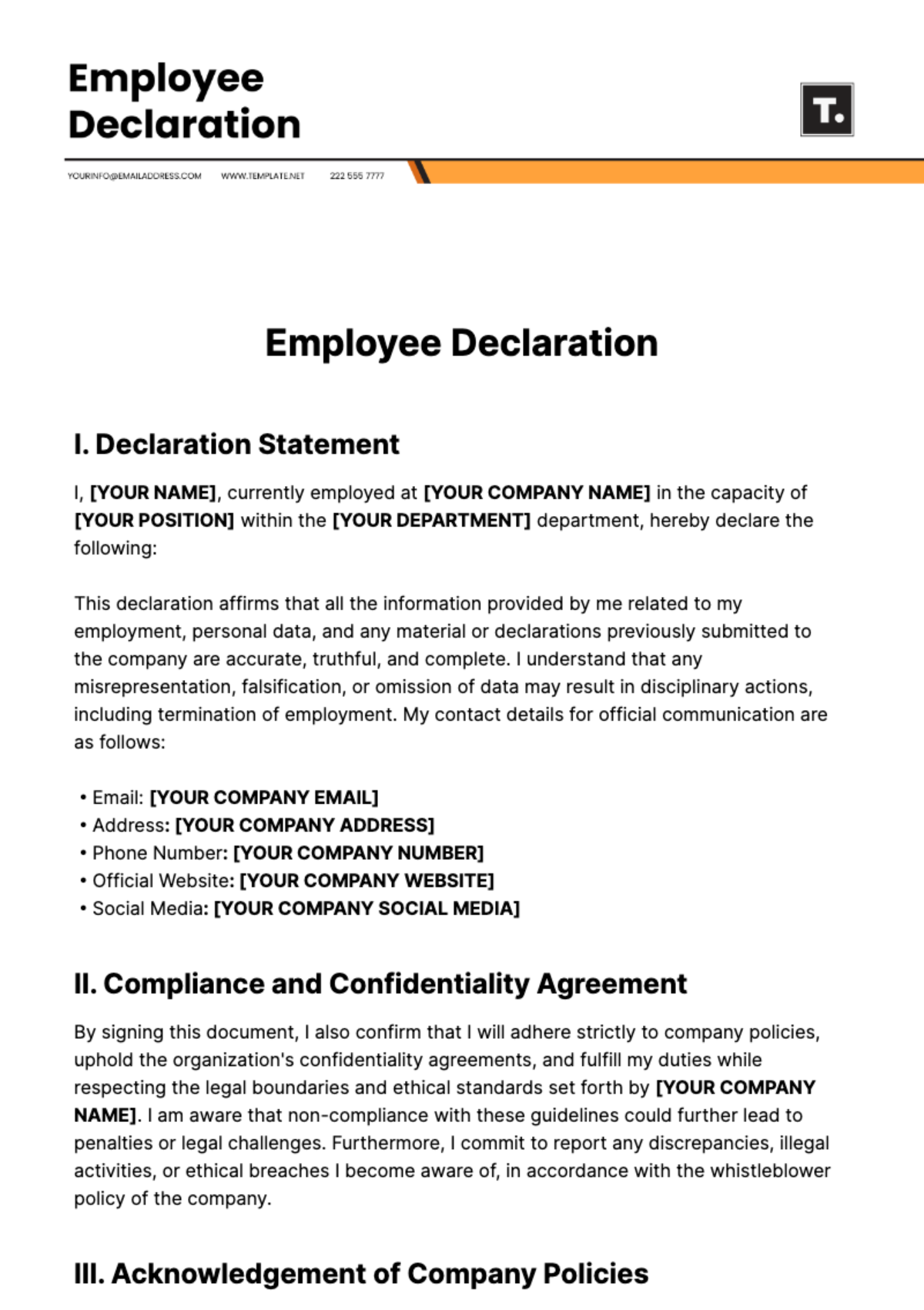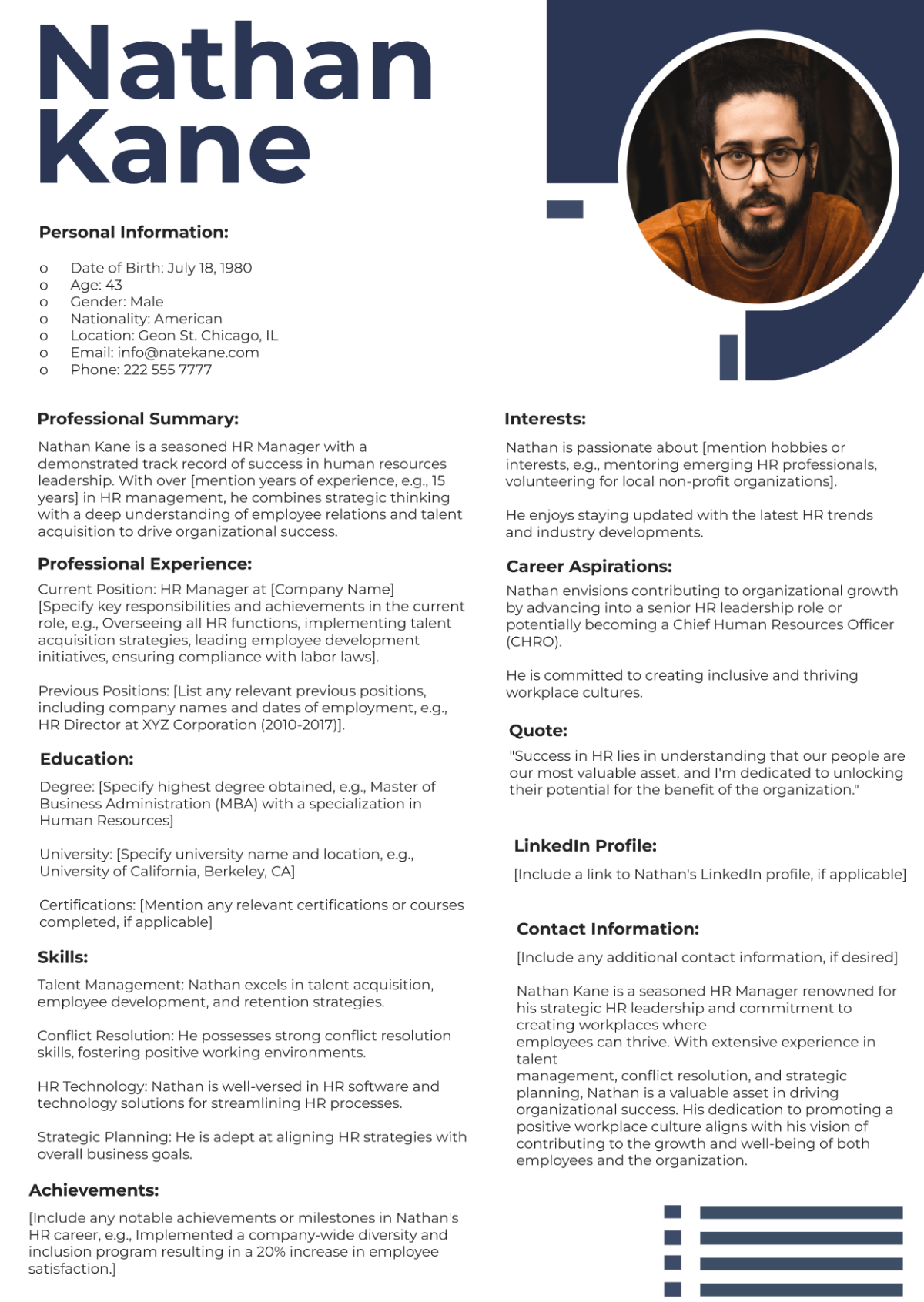Free Employee Belonging and Well-being Study HR

- 100% Customizable, free editor
- Access 1 Million+ Templates, photo’s & graphics
- Download or share as a template
- Click and replace photos, graphics, text, backgrounds
- Resize, crop, AI write & more
- Access advanced editor
Elevate your workplace with this Employee Belonging and Well-being Study HR Template from Template.net. Streamline assessments, analyze data, and drive positive change. Crafted by HR experts, this customizable and editable template empowers organizations to cultivate a culture of well-being and belonging. Transform your workforce and foster happier, by editing the template with our Ai Editor Tool.
You may also like
- Employee Letter
- Employee ID Card
- Employee Checklist
- Employee Certificate
- Employee Report
- Employee Training Checklist
- Employee Agreements
- Employee Contract
- Employee Training Plan
- Employee Incident Report
- Employee Survey
- Employee of the Month Certificate
- Employee Development Plan
- Employee Action Plan
- Employee Roadmap
- Employee Poster
- Employee Form
- Employee Engagement Survey
Employee Belonging and Well-being
Study HR
1. Introduction
In today's dynamic and competitive business landscape, the success of any organization is inextricably linked to the well-being and sense of belonging experienced by its employees. A workforce that feels valued, engaged, and supported is not only more productive but also more likely to stay committed to the organization's mission and objectives. Recognizing this symbiotic relationship between employee well-being, belonging, and organizational success, [Your Company Name] is embarking on a comprehensive Employee Belonging and Well-being Study.
1.1 Rationale and Significance
The contemporary workplace has witnessed a significant evolution in recent years, with factors such as technological advancements, changing demographics, and shifting employee expectations reshaping the landscape of employment. Amidst these transformations, the concept of employee well-being and belonging has gained unprecedented prominence. It is no longer merely a moral obligation for organizations but a strategic imperative.
The rationale behind this study is multifaceted:
Organizational Performance: | [Your Company Name] recognizes that the health, happiness, and sense of belonging of its workforce are directly linked to its performance. A thriving workforce contributes to increased productivity, reduced absenteeism, lower turnover rates, and ultimately, improved financial outcomes. |
Talent Attraction and Retention: | In a competitive job market, attracting and retaining top talent is a constant challenge. Prospective employees are increasingly scrutinizing potential employers for their commitment to employee well-being and inclusive workplace cultures. A robust well-being and belonging program can be a key differentiator for [Your Company Name]. |
Ethical and Social Responsibility: | [Your Company Name] acknowledges its ethical and social responsibility to create an inclusive, supportive, and diverse work environment that prioritizes the mental, emotional, and physical well-being of its employees. This commitment aligns with the organization's values and its dedication to fostering a culture of respect and equity. |
1.2. Objectives of the Study
The primary objectives of the Employee Belonging and Well-being Study are as follows:
a. Understand Employee Well-being: To assess the current state of employee well-being within [Your Company Name] comprehensively. This includes physical health, mental health, work-life balance, and overall job satisfaction.
b. Measure Belongingness: To gauge the degree of belongingness that employees feel within the organization, focusing on inclusion, diversity, and a sense of purpose.
c. Identify Key Factors: To identify the key factors that contribute to or hinder employee well-being and belonging within [Your Company Name], including workplace policies, leadership practices, and the overall organizational culture.
d. Recommend Actionable Solutions: To provide actionable recommendations based on the study findings, aimed at enhancing employee well-being, fostering a greater sense of belonging, and aligning the organization more closely with its employees' needs and aspirations.
In the pages that follow, this report will delve into the comprehensive methodology employed to conduct this study, detailing the data collection processes, analysis techniques, and ethical considerations. Subsequently, it will present the findings, conclusions, and a roadmap for implementing the study's recommendations.
As we embark on this journey to better understand and improve the well-being and belongingness of our workforce, [Your Company Name] remains committed to creating a workplace where every employee can thrive, find purpose, and contribute their best to the organization's continued success. We believe that by investing in the well-being and sense of belonging of our employees, we are not only enriching individual lives but also building a stronger and more resilient organization.
2. Rationale
The research objectives of the Employee Belonging and Well-being Study are carefully crafted to guide the investigation and provide a clear framework for assessing and improving employee well-being and a sense of belonging within [Your Company Name]. These objectives are designed to address key aspects of the study and contribute to the organization's strategic goals:
2.1. Assess Current Employee Well-being
Objective: To comprehensively assess the current state of employee well-being within [Your Company Name] by examining physical, mental, and emotional health, job satisfaction, and overall quality of life.
Rationale: Understanding the existing well-being levels of our workforce is fundamental to identifying areas of concern and improvement. This objective aims to establish a baseline for future well-being initiatives.
2.2. Measure Employee Belongingness
Objective: To measure the extent to which employees feel a sense of belonging within the organization, including their perception of inclusion, diversity, and alignment with the organizational culture and values.
Rationale: Belongingness is a critical factor in employee engagement and retention. This objective aims to gauge the degree to which employees identify with and connect to the organization.
2.3. Identify Contributing and Hindering Factors
Objective: To identify the specific factors and variables that contribute positively or negatively to employee well-being and belonging within [Your Company Name]. This includes exploring workplace policies, leadership practices, communication, and recognition.
Rationale: Pinpointing the key drivers and barriers to well-being and belonging provides actionable insights for designing targeted interventions and improvements.
2.4. Recommend Actionable Strategies
Objective: To provide a set of actionable recommendations based on the study's findings, with a focus on enhancing employee well-being, strengthening the sense of belonging, and aligning the organization more closely with employee needs and aspirations.
Rationale: Recommendations will serve as a roadmap for [Your Company Name] to implement concrete measures aimed at improving the well-being and belongingness of its workforce.
3. Methodology
The methodology of the Employee Belonging and Well-being Study outlines the systematic approach employed to gather, analyze, and interpret data. The chosen methods are designed to ensure the accuracy, reliability, and ethical conduct of the study.
3.1. Research Design
The study will employ a mixed-method research design, combining both quantitative and qualitative approaches. This hybrid approach provides a comprehensive understanding of employee well-being and belonging within [Your Company Name], allowing us to capture both quantitative data for statistical analysis and qualitative insights to contextualize the findings.
3.2. Data Collection Methods
3.2.1. Survey Questionnaires:
Quantitative Phase: | An anonymous online survey will be administered to all employees across various departments and levels. The questionnaire will include structured questions to measure well-being, belongingness, job satisfaction, and demographic information. |
Qualitative Phase: | Open-ended questions will be incorporated into the survey to allow employees to provide detailed qualitative insights regarding their experiences, challenges, and suggestions. |
3.2.2. Interviews:
In-depth semi-structured interviews will be conducted with a representative sample of employees, including those from diverse backgrounds, job roles, and tenure within the organization. Interviews will allow for a deeper exploration of individual experiences and perceptions.
Interviews will be audio-recorded with participants' consent and transcribed for qualitative analysis.
3.2.3. Focus Groups:
Focus group discussions will be organized with small groups of employees to encourage interactive dialogue and generate qualitative data regarding specific themes or topics related to well-being and belonging.
Focus group sessions will be facilitated by experienced moderators and recorded for analysis.
3.3. Sampling
The study will use stratified random sampling to ensure a representative sample of employees. Stratification will be based on job roles, departments, and demographic factors to account for diversity within the organization. The sample size will be determined through power analysis to achieve statistical significance.
4. Data Collection
Effective data collection is essential for gathering comprehensive insights into employee well-being and belonging within [Your Company Name]. This section outlines the timeline for data collection and the process for obtaining informed consent from participants.
4.1. Timeline for Data Collection
The data collection process will be executed in a systematic and organized manner to ensure the accuracy and reliability of the results. The timeline for data collection is as follows:
Phase 1: Survey Questionnaires |
|
Phase 2: Interviews |
|
Phase 3: Focus Groups |
|
4.2. Process for Obtaining Informed Consent
Obtaining informed consent is a fundamental ethical requirement in conducting the Employee Belonging and Well-being Study. The process for obtaining informed consent will be as follows:
4.2.1. Consent Form Development
Prior to the commencement of data collection, a clear and concise informed consent form will be developed. The consent form will include the following components:
Explanation of the study's purpose and objectives.
Description of the data collection methods (e.g., survey, interview, focus group).
Assurance of participant anonymity and confidentiality.
Information on the voluntary nature of participation and the right to withdraw at any time without consequences.
Contact information for the research team for questions or concerns.
4.2.2. Distribution and Explanation of Consent Form
Participants will be provided with the informed consent form along with the invitation to participate in the study. This will be done through email, online survey platforms, or in-person interactions.
The consent form will be accompanied by a clear and detailed explanation of its contents, ensuring that participants understand their rights and responsibilities.
5. Data Analysis
Data analysis is a critical phase of the Employee Belonging and Well-being Study, as it involves the systematic examination and interpretation of collected data to derive meaningful insights and recommendations. This section outlines the methods, techniques, and processes that will be employed for data analysis.
5.1. Data Preparation
Before analysis begins, several preparatory steps will be undertaken to ensure the data is ready for examination:
5.1.1. Data Cleaning:
Survey responses will be carefully reviewed for completeness and accuracy. Any missing or inconsistent data will be addressed to enhance data quality.
5.1.2. Data Coding:
Qualitative data from interviews and focus groups will be coded systematically to identify themes and patterns. A coding framework will be established to facilitate this process.
5.2. Quantitative Analysis
Quantitative data, obtained from survey questionnaires, will be analyzed using statistical methods to identify trends, correlations, and patterns related to employee well-being and belonging. The following analytical techniques will be employed:
5.2.1. Descriptive Statistics:
Descriptive statistics, including mean scores, standard deviations, and frequency distributions, will be computed to provide a snapshot of the data's central tendencies and variations.
5.2.2. Inferential Statistics:
Inferential statistics, such as regression analysis, will be used to examine relationships between variables. For example, regression analysis may be applied to identify factors that significantly predict employee well-being or belonging.
6. Employee Well-being Assessment
Section 1: Physical Well-being
Level 1: Very Poor (1) |
|
Level 2: Poor (2) |
|
Level 3: Neutral (3) |
|
Level 4: Good (4) |
|
Level 5: Excellent (5) |
|
Section 2: Work Environment
Level 1: Very Poor (1) |
|
Level 2: Poor (2) |
|
Level 3: Neutral (3) |
|
Level 4: Good (4) |
|
Level 5: Excellent (5) |
|
7. Conclusion
The Employee Belonging and Well-being Study undertaken at [Your Company Name] has provided valuable insights into the well-being of our workforce and the prevailing organizational culture. This comprehensive study was designed to assess physical, mental, and emotional well-being, work-life balance, and the factors that influence employee satisfaction and engagement. It also aimed to evaluate the alignment of our workplace culture with employee values, the level of leadership support, communication effectiveness, and recognition practices.
Recommendations
Based on the findings of this study, the following recommendations are proposed:
Well-being Programs: Develop and expand wellness programs that cater to the diverse well-being needs of our employees, including physical fitness initiatives, health screenings, and stress management workshops.
Mental Health Support: Increase awareness of and access to mental health resources, such as counseling services and employee assistance programs, to support employees' emotional well-being.
Work-Life Balance: Encourage flexible work arrangements, remote work options, and clear guidelines on overtime to help employees achieve a healthier work-life balance.
Cultural Alignment: Strengthen efforts to align the organizational culture with employee values by promoting diversity and inclusion, fostering mutual respect, and celebrating our shared principles.
Leadership Support: Provide leadership training and coaching to enhance supervisors' abilities to support their teams, listen to concerns, and provide constructive feedback.
Communication Enhancement: Improve communication channels, facilitate regular team meetings, and ensure timely and transparent dissemination of information regarding organizational changes.
Recognition Programs: Enhance and expand recognition and appreciation programs, including peer recognition, to acknowledge outstanding performance and contributions.





























